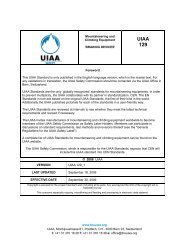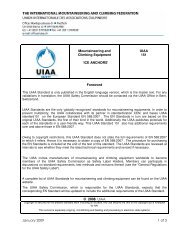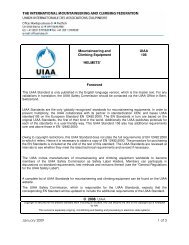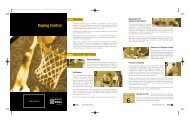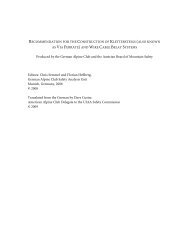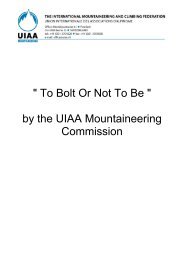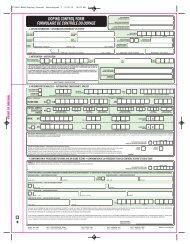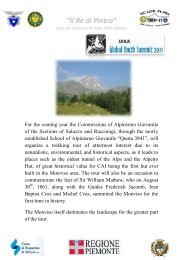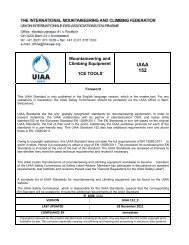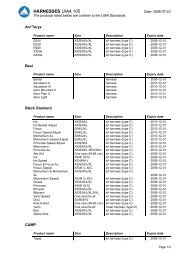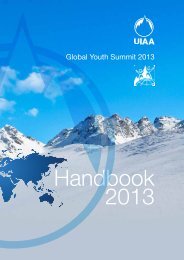UIAA Standards for Voluntary Leaders and Instructors
UIAA Standards for Voluntary Leaders and Instructors
UIAA Standards for Voluntary Leaders and Instructors
You also want an ePaper? Increase the reach of your titles
YUMPU automatically turns print PDFs into web optimized ePapers that Google loves.
INTERNATIONAL MOUNTAINEERING AND CLIMBING FEDERATION<br />
UNION INTERNATIONALE DES ASSOCIATIONS D’ALPINISME<br />
<strong>UIAA</strong> <strong>St<strong>and</strong>ards</strong> <strong>for</strong> <strong>Voluntary</strong> <strong>Leaders</strong> <strong>and</strong> <strong>Instructors</strong><br />
Guidance notes <strong>for</strong> Member Associations’ training <strong>and</strong> assessment schemes<br />
Introduction <strong>and</strong> summary<br />
A. General Requirements<br />
1. Evaluation Procedure<br />
2. Common basis<br />
3. Approval<br />
B. Activity <strong>St<strong>and</strong>ards</strong><br />
Specifications <strong>for</strong> pre-training experience, skills <strong>and</strong> knowledge<br />
1. Mountain Walking <strong>and</strong> Trekking (summer)<br />
2. Winter Mountain Walking <strong>and</strong> Snowshoeing<br />
3. Sport Climbing (indoor <strong>and</strong> outdoor)<br />
4. Rock Climbing (leader placed protection)<br />
5. Ice Climbing<br />
6. Alpine Climbing<br />
7. Ski Mountaineering<br />
C. Additional Requirements<br />
Additional syllabus <strong>and</strong> scheme requirements <strong>for</strong> specific environments<br />
1. High Altitude<br />
2. Specific Regions<br />
3. Avalanche Terrain<br />
Annexe
Background<br />
Introduction<br />
The <strong>UIAA</strong> Mountaineering Commission developed Model Training <strong>St<strong>and</strong>ards</strong> <strong>for</strong> <strong>Voluntary</strong> <strong>Leaders</strong> <strong>and</strong><br />
<strong>Instructors</strong> in response to requests from Member Associations <strong>for</strong> guidance on widely accepted good<br />
practice <strong>and</strong> st<strong>and</strong>ards <strong>for</strong> training schemes. These were adopted by the General Assembly in 1993<br />
(Santiago de Chile) <strong>and</strong> the Mountaineering Commission <strong>for</strong>med a Training <strong>St<strong>and</strong>ards</strong> Working Group<br />
(TSWG) to assist Member Associations wishing to use the original four st<strong>and</strong>ards. In 2001 <strong>and</strong> 2003<br />
the TSWG held seminars (Le Tour, France) to discuss the use <strong>and</strong> application of the st<strong>and</strong>ards. 39<br />
st<strong>and</strong>ards were approved between 1993 <strong>and</strong> 2005,<br />
Developments in 2005<br />
After a period of over 10 years successful use of the st<strong>and</strong>ards, a third TSWG seminar was held in June<br />
2005 (Steingletscher, Switzerl<strong>and</strong>). This seminar reviewed the content <strong>and</strong> structure of the existing<br />
st<strong>and</strong>ards <strong>and</strong> discussed the need <strong>for</strong> modifications <strong>and</strong> additional st<strong>and</strong>ards. The seminar noted that:<br />
The needs <strong>and</strong> circumstances of Member Associations can be very different around the world.<br />
The expertise in national training requirements is in the Member Associations.<br />
The TSWG provides a very valuable service to national federations by evaluating their training<br />
schemes <strong>and</strong> verifying these meet common international st<strong>and</strong>ards.<br />
Hence, in order to better accommodate to the needs of Member Associations the seminar proposed to<br />
build on the success of the four original st<strong>and</strong>ards by:<br />
a) Creating a flexible framework <strong>for</strong> activities that could better accommodate the different needs<br />
<strong>and</strong> circumstances of federations around the world.<br />
b) Place greater emphasis on the process <strong>for</strong> evaluating the scheme <strong>and</strong> the work between the<br />
TSWG Expert <strong>and</strong> the Member Association.<br />
The above proposal represented a shift in emphasis away from the concept of uni<strong>for</strong>m technical<br />
st<strong>and</strong>ards <strong>for</strong> the c<strong>and</strong>idates being trained by the Member Associations, <strong>and</strong> towards the quality of the<br />
process by which the c<strong>and</strong>idates are trained <strong>and</strong> assessed. The proposals from the seminar were<br />
further refined by the TSWG <strong>and</strong> the Mountaineering Commission, <strong>and</strong> were adopted as the new basis<br />
<strong>for</strong> evaluating training schemes from October 2006.<br />
The TSWG welcomes comments on the Training <strong>St<strong>and</strong>ards</strong>, <strong>and</strong> will revise them from time to time.<br />
Scope<br />
Member Associations have total discretion to use or not use the Training <strong>St<strong>and</strong>ards</strong> in their own country.<br />
There is no <strong>UIAA</strong> requirement to make use of the <strong>St<strong>and</strong>ards</strong> or the evaluation offered by the TSWG.<br />
Member Associations alone have the responsibility <strong>for</strong> training <strong>and</strong> assessing their national leaders <strong>and</strong><br />
instructors. The Member Associations also have the responsibility to ensure that requirements are met<br />
<strong>for</strong> relevant national legislation <strong>and</strong> insurance.<br />
The use of the <strong>UIAA</strong> Training <strong>St<strong>and</strong>ards</strong> is a means by which Member Associations can demonstrate<br />
their training <strong>and</strong> assessment schemes have been independently evaluated <strong>and</strong> meet accepted<br />
st<strong>and</strong>ards. The use of the st<strong>and</strong>ards also allows opportunities <strong>for</strong> mutual recognition of qualifications<br />
between Member Associations.
The TSWG has developed the Training <strong>St<strong>and</strong>ards</strong> specifically with the needs in mind of Member<br />
Associations <strong>and</strong> their leaders <strong>and</strong> instructors working in a voluntary capacity with other members of<br />
their federation. However, Member Associations may wish to apply the <strong>St<strong>and</strong>ards</strong> in wider<br />
circumstances (e.g. <strong>for</strong> leaders <strong>and</strong> instructors who are paid, <strong>and</strong> who might be working with the public).<br />
Where this is the case, the Member Association concerned is responsible <strong>for</strong> ensuring their scheme<br />
meets the applicable st<strong>and</strong>ards in their country <strong>for</strong> the wider application of the <strong>UIAA</strong> Training <strong>St<strong>and</strong>ards</strong>.<br />
In the context of the <strong>UIAA</strong> Training <strong>St<strong>and</strong>ards</strong> the following definitions apply:<br />
A leader is a person who can take responsibility <strong>for</strong> other people <strong>and</strong> lead or supervise an activity.<br />
An instructor is a person who can teach people including beginners so they are competent to take part<br />
in an activity.<br />
Application <strong>and</strong> Evaluation<br />
Member Associations wishing to apply <strong>for</strong> a <strong>UIAA</strong> Training St<strong>and</strong>ard should contact the President of the<br />
TSWG (who is contactable via the <strong>UIAA</strong> office). The TSWG will appoint an Expert to work with the<br />
Member Association <strong>and</strong> evaluate the proposed Scheme. The expert will:<br />
a) Evaluate the scheme that has been proposed in relation to the relevant <strong>UIAA</strong> Training St<strong>and</strong>ard.<br />
And where appropriate:<br />
b) Help the Member Association improve their scheme <strong>and</strong> meet the <strong>UIAA</strong> Training St<strong>and</strong>ard.<br />
c) Produce a report <strong>and</strong> make a recommendation to the <strong>UIAA</strong> Mountaineering Commission.<br />
The process of the Member Association working with the TSWG <strong>and</strong> the Expert is the most important<br />
<strong>and</strong> valuable aspect of the <strong>UIAA</strong> Training St<strong>and</strong>ard.<br />
1. Evaluation<br />
A. General Requirements<br />
Documentation<br />
The first step is <strong>for</strong> the Member Association to submit a dossier with all the relevant in<strong>for</strong>mation <strong>and</strong><br />
documentation about the scheme that they wish to be evaluated. This will then be reviewed by the<br />
TSWG, <strong>and</strong> an Expert will be appointed to work with the Member Association to carry out the evaluation.<br />
The dossier should contain an outline of the training scheme that is being submitted <strong>for</strong> approval. The<br />
scheme should contain a training course, an experience period, <strong>and</strong> an assessment course.<br />
The proposed scheme can be <strong>for</strong> a leader or an instructor. If the scheme is <strong>for</strong> an instructor, the<br />
c<strong>and</strong>idate must be assessed <strong>for</strong> their teaching skills.<br />
The proposed scheme should include the following in<strong>for</strong>mation:<br />
The purpose of the scheme.<br />
Description of the qualification.<br />
Definition of the qualification holder’s role.
Definition of the limits of the qualification.<br />
C<strong>and</strong>idates’ pre-training requirements (this must include first aid).<br />
The skills <strong>and</strong> knowledge included in the training <strong>and</strong> the means by which they will be assessed<br />
(see requirements in section B <strong>and</strong> C).<br />
The requirements <strong>for</strong> on-going training of the qualification holder, <strong>and</strong> the revalidation of the<br />
qualification.<br />
The qualification may be in different <strong>for</strong>mats depending upon the circumstances <strong>and</strong> needs of the<br />
Member Association. The <strong>for</strong>mat of the qualification may be one or more of the following:<br />
Award<br />
Certificate<br />
Log book<br />
Licence<br />
Evaluation visit<br />
Once any points of clarification in the documentation have been dealt with, the Expert <strong>and</strong> Member<br />
Association will agree a visit (or visits) to evaluate the proposed scheme.<br />
Cost<br />
The costs of evaluation visits are the responsibility of the Member Association requesting approval,<br />
though the experts are often able to provide their time without charge. However, the <strong>UIAA</strong> has a modest<br />
development budget that may be available in some circumstances, <strong>and</strong> the <strong>UIAA</strong> is willing to assist in<br />
applications <strong>for</strong> development funding from other agencies.<br />
Evaluation categories<br />
The TSWG Expert will review whatever aspects he or she believes is relevant to the application made<br />
by the Member Association, but this will include:<br />
Member Association representation of Federation<br />
Adequate facilities<br />
Appropriate terrain<br />
Competent senior instructors<br />
C<strong>and</strong>idates with appropriate experience <strong>and</strong> skills, who are fit to be trained <strong>and</strong> assessed<br />
Programme design <strong>and</strong> management<br />
Training methods<br />
Assessment procedures<br />
Scheme review system<br />
Procedure <strong>for</strong> dealing with complaints <strong>and</strong> appeals<br />
2. Common Basis
The title '<strong>UIAA</strong> Training St<strong>and</strong>ard' indicates that a Member Association has a structured training <strong>and</strong><br />
assessment scheme <strong>for</strong> voluntary leaders <strong>and</strong>/or, instructors that has been validated by independent<br />
examination by a <strong>UIAA</strong> Expert.<br />
The designation of the title '<strong>UIAA</strong> Training St<strong>and</strong>ard' to a Member Association is an indication that the<br />
training <strong>and</strong> assessment scheme meets the relevant technical st<strong>and</strong>ards <strong>for</strong> the activity bearing in mind<br />
the needs of the federation <strong>and</strong> the environment <strong>and</strong> facilities in their country.<br />
The designation is also an indication that the Federation’s scheme is in accordance with other <strong>UIAA</strong><br />
policies such as the Environmental Guidelines <strong>and</strong> Objectives <strong>and</strong> the Summit Charter (both available<br />
from the <strong>UIAA</strong> website). For example, the Summit Charter includes the <strong>UIAA</strong>’s commitment to<br />
promoting equal opportunities <strong>for</strong> all people taking part in climbing <strong>and</strong> mountaineering. There<strong>for</strong>e,<br />
training schemes are expected to demonstrate a positive attitude towards equal opportunities. (Equality<br />
of access)<br />
3. Approval<br />
Once the Expert has completed the evaluation, he or she will submit a report to the TSWG. The<br />
President of the TSWG will in<strong>for</strong>m the Member Association of the outcome of the evaluation, if they<br />
have been awarded the ‘<strong>UIAA</strong> Training St<strong>and</strong>ard’, <strong>and</strong> if there are any special considerations or<br />
limitations that might apply.<br />
The authorisation to use the term ‘<strong>UIAA</strong> Training St<strong>and</strong>ard’ may only be applied by the Member<br />
Association to the specific scheme that has been evaluated. The authorisation may be withdrawn by the<br />
TSWG if it is concerned that the scheme no longer meets the relevant st<strong>and</strong>ard or the constitution of the<br />
Member Association has substantially changed, but normally the authorisation is valid <strong>for</strong> a period of 5<br />
years <strong>and</strong> can be renewed. The <strong>UIAA</strong> reserves the right to review the articles of association of the<br />
Member Association within the 5 year period.<br />
Once authorised the Member Association may use the <strong>UIAA</strong> logo <strong>and</strong> term ‘<strong>UIAA</strong> Training St<strong>and</strong>ard’ on<br />
the documentation <strong>for</strong> the approved scheme <strong>and</strong> any certificates or identity cards held by the qualified<br />
persons. The certificate or identity card must clearly state the scope <strong>and</strong> limits of the qualification held,<br />
<strong>and</strong> the identity of the person holding the qualification.<br />
B. Activity <strong>St<strong>and</strong>ards</strong><br />
The following set out the minimum specifications <strong>for</strong> pre-training experience, skills <strong>and</strong> knowledge that<br />
should be the content of the scheme being proposed <strong>for</strong> approval. Where appropriate the Activity<br />
<strong>St<strong>and</strong>ards</strong> may be used in combination. If the proposed scheme includes activities at high-altitude, in<br />
tropical regions or avalanche terrain, it must be used in conjunction with the relevant Additional<br />
<strong>St<strong>and</strong>ards</strong>.<br />
1. Mountain Walking <strong>and</strong> Trekking (summer)<br />
This st<strong>and</strong>ard may include steep terrain, scrambling, <strong>and</strong> overcoming obstacles such as small rock<br />
steps <strong>and</strong> patches of snow or ice. This st<strong>and</strong>ard is not designed <strong>for</strong> use in situations that require the<br />
techniques of mountaineering to make progress, such as rock or ice climbing.
1.1 The scheme must define the type of terrain that it applies to, <strong>and</strong> the type of terrain that is<br />
outside the scope of the qualification.<br />
1.2 The c<strong>and</strong>idate should not be less than 18 years old at the time of assessment.<br />
1.3 Pre training experience<br />
The scheme must include a defined minimum of experience (e.g. years, number <strong>and</strong> type of<br />
mountain walks or treks, different areas <strong>and</strong> terrain, etc.).<br />
1.4 Skills<br />
The scheme should test the c<strong>and</strong>idates’ ability to demonstrate effective personal techniques <strong>and</strong><br />
ability in the following areas:<br />
1. Safe movement ascending, descending <strong>and</strong> traversing mountain terrain including:<br />
Steep ground*<br />
‘Broken’ or uneven terrain*<br />
Ridges*<br />
Gullies*<br />
Easy rock steps*<br />
Snow covered ground*<br />
2. Basic rope work*<br />
3. Route finding <strong>and</strong> navigation through typical <strong>and</strong> difficult terrain<br />
4. Journey planning <strong>for</strong> groups<br />
5. Organisation <strong>and</strong> group leadership<br />
6. Camping <strong>and</strong> bivouacs<br />
7. Avoiding <strong>and</strong> solving common problems<br />
8. Emergency procedures<br />
9. First aid<br />
* If included in the scope of the scheme<br />
1.5 Knowledge<br />
The scheme should test the c<strong>and</strong>idates’ knowledge about <strong>and</strong> their ability to give advice on the<br />
following:<br />
1. Recognition <strong>and</strong> treatment of exhaustion, hypothermia, cold injury <strong>and</strong> heat<br />
disorders<br />
2. Terrain <strong>and</strong> weather hazards<br />
3. Journey planning, route choice, route grades, way marks <strong>and</strong> guidebooks<br />
4. Camping <strong>and</strong> mountain huts<br />
5. Nutrition<br />
6. Physiology <strong>and</strong> injury prevention<br />
7. Emergency procedures<br />
8. Environment <strong>and</strong> mountain culture<br />
9. Access<br />
10. Legal liability <strong>and</strong> insurance<br />
11. Training<br />
2. Winter Mountain Walking <strong>and</strong> Snowshoeing<br />
This st<strong>and</strong>ard may be limited to low angle terrain or tracks that have very limited exposure to avalanche<br />
hazards or are in avalanche-controlled areas. However, if the scope of the scheme is to include travel<br />
in avalanche terrain it must be used in conjunction with the Avalanche st<strong>and</strong>ard. This st<strong>and</strong>ard is not
designed <strong>for</strong> use in situations that require the techniques of mountaineering to make progress, such as<br />
rock or ice climbing.<br />
2.1 The scheme must define the type of terrain that it applies to, <strong>and</strong> the type of terrain that is<br />
outside the scope of the qualification.<br />
2.2 The c<strong>and</strong>idate should not be less than 18 years old at the time of assessment.<br />
2.3 Pre training experience<br />
The scheme must include a defined minimum of experience (e.g. years, number <strong>and</strong> type of<br />
mountain walks or treks, different areas <strong>and</strong> terrain, etc.).<br />
2.4 Skills<br />
The scheme should test the c<strong>and</strong>idates’ ability to demonstrate effective personal techniques <strong>and</strong><br />
ability in the following areas:<br />
1. Safe movement ascending, descending <strong>and</strong> traversing mountain terrain including:<br />
Steep ground*<br />
‘Broken’ or uneven terrain*<br />
Ridges*<br />
Gullies*<br />
Easy rock steps*<br />
2. Basic rope work*<br />
3. Route finding <strong>and</strong> navigation through typical <strong>and</strong> difficult terrain<br />
4. Journey planning <strong>for</strong> groups<br />
5. Organisation <strong>and</strong> group leadership<br />
6. Camping <strong>and</strong> bivouacs<br />
7. Avoiding <strong>and</strong> solving common problems<br />
8. Emergency procedures<br />
9. First aid<br />
* If included in the scope of the scheme<br />
2.5 Knowledge<br />
The scheme should test the c<strong>and</strong>idates’ knowledge about <strong>and</strong> their ability to give advice on the<br />
following:<br />
1. Recognition <strong>and</strong> treatment of exhaustion, hypothermia, cold injury <strong>and</strong> heat<br />
disorders<br />
2. Terrain <strong>and</strong> weather hazards<br />
3. Avalanche hazard awareness<br />
4. Journey planning, route choice, route grades, way marks <strong>and</strong> guidebooks<br />
5. Camping <strong>and</strong> mountain huts<br />
6. Nutrition<br />
7. Physiology <strong>and</strong> injury prevention<br />
8. Emergency procedures<br />
9. Environment <strong>and</strong> mountain culture<br />
10. Access<br />
11. Legal liability <strong>and</strong> insurance<br />
12. Training<br />
3. Sport Climbing (i.e. single or multi-pitch fixed equipment)
A sport climb is defined as being fully equipped with bolts <strong>for</strong> protection <strong>and</strong> belay anchors. This<br />
st<strong>and</strong>ard is only valid <strong>for</strong> climbing areas with easy approaches <strong>and</strong> descents (i.e. no navigation or<br />
mountaineering skills required).<br />
3.1 The scheme must define if it is limited to single pitch climbs, multi pitch climbs <strong>and</strong>/or artificial<br />
climbing walls. .<br />
3.2 The c<strong>and</strong>idate should not be less than 18 years old at the time of assessment.<br />
3.3 Pre training experience<br />
- The c<strong>and</strong>idate must have experience of on-sight leading grade 5 (<strong>UIAA</strong>).<br />
- The scheme must include a defined minimum of experience (e.g. years, number of climbs,<br />
rock types, areas, etc.).<br />
3.4 Skills<br />
The scheme should test the c<strong>and</strong>idates’ ability to demonstrate effective personal techniques <strong>and</strong><br />
ability in the following areas:<br />
1. On-sight lead efficiently<br />
2. Climbing movement skills<br />
3. Bouldering<br />
4. Basic coaching <strong>and</strong> teaching<br />
5. Group management <strong>and</strong> leadership<br />
6. Climbing calls<br />
7. Rope management, knots, quick draws, belays <strong>and</strong> belaying<br />
8. Abseiling<br />
9. Emergency procedures<br />
10. Avoiding <strong>and</strong> solving common problems<br />
11. First aid<br />
3.5 Knowledge<br />
The scheme should test the c<strong>and</strong>idates’ knowledge about <strong>and</strong> their ability to give advice on the<br />
following:<br />
1. Climbing equipment (e.g. footwear, belay devices <strong>and</strong> descenders, helmets, harness,<br />
ropes, slings, karabiners, etc.)<br />
2. Care of equipment<br />
3. Safety chains <strong>and</strong> fall factors<br />
4. Types of bolts <strong>and</strong> anchors<br />
5. Rock types<br />
6. Ethics <strong>and</strong> tradition<br />
7. Route choice, grades <strong>and</strong> use of guidebooks<br />
8. Environment <strong>and</strong> access<br />
9. Risk management, safety <strong>and</strong> emergency procedures<br />
10. Nutrition<br />
11. Physiology <strong>and</strong> injury prevention<br />
12. Personal liability <strong>and</strong> insurance<br />
13. Training<br />
14. Competitions
4. Rock Climbing (with leader placed protection, <strong>and</strong> single or multipitch)<br />
This st<strong>and</strong>ard is only valid <strong>for</strong> climbing areas with easy approaches <strong>and</strong> descents (i.e. no navigation or<br />
mountaineering skills required) unless it is combined with the Mountain Walking <strong>and</strong> Trekking (summer)<br />
st<strong>and</strong>ard.<br />
4.1 The scheme must define if it is <strong>for</strong> single pitch or multi pitch climbs.<br />
4.2 The c<strong>and</strong>idate should not be less than 18 years old at the time of assessment.<br />
4.3 Pre training experience<br />
- The c<strong>and</strong>idate must have experience of on-sight leading 5 (<strong>UIAA</strong>).<br />
- The scheme must include a defined minimum of experience (e.g. years, number of climbs,<br />
rock types, areas, etc.).<br />
4.4 Skills<br />
The scheme should test the c<strong>and</strong>idates’ ability to demonstrate effective personal techniques <strong>and</strong><br />
ability in the following areas:<br />
1. On-sight lead efficiently<br />
2. Select <strong>and</strong> place protection equipment including multi-point anchors<br />
3. Rope management, knots, running belays, <strong>and</strong> belaying<br />
4. Single <strong>and</strong> double rope techniques<br />
5. Route finding<br />
6. Climbing movement skills<br />
7. Bouldering<br />
8. Basic coaching <strong>and</strong> teaching<br />
9. Group management <strong>and</strong> leadership<br />
10. Climbing calls<br />
11. Abseiling<br />
12. Emergency procedures<br />
13. Avoiding <strong>and</strong> solving common problems<br />
14. First aid<br />
4.5 Knowledge<br />
The scheme should test the c<strong>and</strong>idates’ knowledge about <strong>and</strong> their ability to give advice on the<br />
following:<br />
1. Climbing equipment (e.g. footwear, belay devices <strong>and</strong> descenders, helmets, harness,<br />
ropes, slings, karabiners, protection equipment, etc.)<br />
2. Care of equipment<br />
3. Types of anchors (chocks, camming devices, bolts, etc.)<br />
4. Dynamic safety system (e.g. impact <strong>for</strong>ces, safety chain <strong>and</strong> fall factors).<br />
5. Rock types<br />
6. Ethics <strong>and</strong> tradition<br />
7. Route choice, grades <strong>and</strong> use of guidebooks<br />
8. Environment <strong>and</strong> access<br />
9. Risk management, safety <strong>and</strong> emergency procedures<br />
10. Nutrition<br />
11. Physiology <strong>and</strong> injury prevention<br />
12. Personal liability <strong>and</strong> insurance<br />
13. Training
5. ICE CLIMBING<br />
This st<strong>and</strong>ard is only valid <strong>for</strong> climbs with easy approaches <strong>and</strong> descents (i.e. no navigation skills<br />
required <strong>and</strong> minimal exposure to hazards). If the scope of the scheme is to include travel in avalanche<br />
terrain, it must be used in conjunction with the Avalanche st<strong>and</strong>ard.<br />
5.1 The scheme must define if it includes dry tooling <strong>and</strong>/or mixed climbing.<br />
5.2 The c<strong>and</strong>idate should not be less than 18 years old at the time of assessment.<br />
5.3 Pre training experience<br />
- The c<strong>and</strong>idate must have experience of leading multi-pitch ice climbs at grade WI III.<br />
- The scheme must include a defined minimum of experience (e.g. years, number <strong>and</strong> type of<br />
climbs, areas, etc.).<br />
5.4 Skills<br />
The scheme should test the c<strong>and</strong>idates’ ability to demonstrate effective personal techniques <strong>and</strong><br />
ability in the following areas:<br />
1. On-sight lead efficiently<br />
2. Select <strong>and</strong> place protection equipment including multi-point anchors<br />
3. Rope management, knots, running belays, <strong>and</strong> belaying<br />
4. Single, twin <strong>and</strong> double rope techniques<br />
5. Route finding<br />
6. Climbing movement skills<br />
7. Basic coaching <strong>and</strong> teaching<br />
8. Group management <strong>and</strong> leadership<br />
9. Climbing calls<br />
10. Abseiling<br />
11. Emergency procedures<br />
12. Avoiding <strong>and</strong> solving common problems<br />
13. First aid<br />
5.5 Knowledge<br />
The scheme should test the c<strong>and</strong>idates’ knowledge about <strong>and</strong> their ability to give advice on the<br />
following:<br />
1. Climbing equipment (e.g. ice tools, crampons, footwear, clothing, ice screws,<br />
belay devices <strong>and</strong> descenders, helmets, harness, ropes, slings, karabiners,<br />
protection equipment, etc.)<br />
2. Care of equipment<br />
3. Risk management, safety <strong>and</strong> emergency procedures<br />
4. Dynamic safety system (e.g. impact <strong>for</strong>ces, safety chain <strong>and</strong> fall factors).<br />
5. Winter hazards.<br />
6. Managing in the cold environment.<br />
7. Prevention <strong>and</strong> treatment of cold injury <strong>and</strong> hypothermia.<br />
8. Protection from solar radiation.<br />
9. Ice types <strong>and</strong> <strong>for</strong>mations<br />
10. Ethics <strong>and</strong> tradition<br />
11. Different climbing styles <strong>and</strong> techniques<br />
12. Dry-tooling <strong>and</strong> mixed climbing<br />
13. Route choice, grades <strong>and</strong> use of guidebooks
6. Alpine Climbing<br />
14. Environment <strong>and</strong> access<br />
15. Nutrition<br />
16. Physiology <strong>and</strong> injury prevention<br />
17. Personal liability <strong>and</strong> insurance<br />
18. Training<br />
6.1 The scheme must define the type of terrain that it applies to, <strong>and</strong> the type of terrain (if any) that<br />
is outside the scope of the qualification.<br />
6.2 The c<strong>and</strong>idate should not be less than 21 years old at the time of assessment.<br />
6.3 Pre training experience<br />
The scheme must include a defined minimum of experience (e.g. years, number <strong>and</strong> type of<br />
journeys <strong>and</strong> ascents, different areas, etc.). C<strong>and</strong>idates should be:<br />
Active alpine climbers with experience of ascents on snow, ice <strong>and</strong> rock.<br />
Able to lead <strong>UIAA</strong> Grade 4 alpine rock <strong>and</strong> 50° ice.<br />
Experienced in glacier travel.<br />
6.4 Skills<br />
The scheme should test the c<strong>and</strong>idates’ ability to demonstrate effective personal techniques <strong>and</strong><br />
ability in the following areas:<br />
1. Safe movement ascending, descending <strong>and</strong> traversing alpine terrain including:<br />
Steep ground<br />
Ridges<br />
Gullies<br />
Rock, ice <strong>and</strong> mixed steps<br />
Glacier travel<br />
Crevasse evacuation techniques<br />
2. Use of ice axe <strong>and</strong> crampons<br />
3. On-sight lead rock, ice <strong>and</strong> mixed ground efficiently<br />
4. Select <strong>and</strong> place protection equipment including multi-point anchors<br />
5. Rope management, knots, running belays, <strong>and</strong> belaying<br />
6. Single, twin <strong>and</strong> double rope techniques<br />
7. Route finding <strong>and</strong> navigation<br />
8. Climbing movement skills<br />
9. Basic coaching <strong>and</strong> teaching<br />
10. Group management <strong>and</strong> leadership<br />
11. Climbing calls<br />
12. Abseiling<br />
13. Emergency procedures<br />
14. Avoiding <strong>and</strong> solving common problems<br />
15. First aid<br />
5.5 Knowledge<br />
The scheme should test the c<strong>and</strong>idates’ knowledge about <strong>and</strong> their ability to give advice on the<br />
following:
1. Climbing equipment (e.g. ice tools, crampons, footwear, clothing, ice screws,<br />
belay devices <strong>and</strong> descenders, helmets, harness, ropes, slings, karabiners,<br />
protection equipment, etc.)<br />
2. Care of equipment<br />
3. Terrain <strong>and</strong> weather hazards<br />
4. Risk management, safety <strong>and</strong> emergency procedures<br />
5. Dynamic safety system (e.g. impact <strong>for</strong>ces, safety chain <strong>and</strong> fall factors)<br />
6. Prevention <strong>and</strong> treatment of cold injury <strong>and</strong> hypothermia<br />
7. Protection from solar radiation<br />
8. Ethics <strong>and</strong> tradition<br />
9. Different climbing styles <strong>and</strong> techniques<br />
10. Route choice, grades <strong>and</strong> use of guidebooks<br />
11. Environment <strong>and</strong> access<br />
12. Nutrition<br />
13. Physiology <strong>and</strong> injury prevention<br />
14. Personal liability <strong>and</strong> insurance<br />
15. Training<br />
7. Ski Mountaineering<br />
This st<strong>and</strong>ard must be used in conjunction with the Avalanche St<strong>and</strong>ard (section C).<br />
7.1 The scheme must define the type of terrain that it applies to, <strong>and</strong> the type of terrain (if any) that<br />
is outside the scope of the qualification (e.g. if the scheme includes glacier terrain or not).<br />
7.2 The c<strong>and</strong>idate should not be less than 21 years old at the time of assessment.<br />
6.3 Pre training experience<br />
The scheme must include a defined minimum of experience (e.g. years, number <strong>and</strong> type of<br />
tours <strong>and</strong> journeys, different areas, etc.). C<strong>and</strong>idates should be:<br />
Active ski mountaineers with experience of ascents, descents <strong>and</strong> multi-day tours.<br />
Able to ski in control off-piste in difficult snow conditions.<br />
Knowledgeable about safe glacier travel <strong>and</strong> alpine mountaineering techniques*<br />
6.4 Skills<br />
The scheme should test the c<strong>and</strong>idates’ ability to demonstrate effective personal techniques <strong>and</strong><br />
ability in the following areas:<br />
1. Good downhill skiing technique in a variety of off-piste snow conditions<br />
2. Good ascending technique on skins <strong>and</strong> crampons<br />
3. Risk awareness <strong>and</strong> risk reduction<br />
4. Route finding <strong>and</strong> navigation<br />
5. Glacier travel <strong>and</strong> crevasse evacuation*<br />
6. Alpine mountaineering techniques*<br />
7. Basic coaching <strong>and</strong> teaching<br />
8. Group management <strong>and</strong> leadership<br />
9. Emergency procedures<br />
10. Avoiding <strong>and</strong> solving common problems<br />
11. First aid<br />
*If included in the scope of the scheme
5.5 Knowledge<br />
The scheme should test the c<strong>and</strong>idates’ knowledge about <strong>and</strong> their ability to give advice on the<br />
following:<br />
1. Ski mountaineering equipment <strong>and</strong> clothing<br />
2. Care of equipment<br />
3. Terrain <strong>and</strong> weather hazards<br />
4. Risk management, safety <strong>and</strong> emergency procedures<br />
5. Prevention <strong>and</strong> treatment of cold injury <strong>and</strong> hypothermia<br />
6. Protection from solar radiation<br />
7. Traditions <strong>and</strong> ski mountaineering competitions<br />
8. Route choice, grades <strong>and</strong> use of guidebooks<br />
9. Environment <strong>and</strong> access<br />
10. Nutrition<br />
11. Physiology <strong>and</strong> injury prevention<br />
12. Personal liability <strong>and</strong> insurance<br />
13. Training<br />
C. Additional Requirements<br />
The Additional Requirements are to be used where appropriate with the Activity <strong>St<strong>and</strong>ards</strong>.<br />
1. High Altitude<br />
The scheme must include experience, skills <strong>and</strong> knowledge about:<br />
1. The process of acclimatisation<br />
2. The symptoms <strong>and</strong> treatment <strong>for</strong> mountain sickness<br />
3. Emergency procedures in the event of acute mountain sickness<br />
2. Specific Regions<br />
The scheme must include experience, skills <strong>and</strong> knowledge about:<br />
1. Special environmental considerations<br />
2. Special environmental hazards<br />
3. Survival techniques<br />
3. Avalanche Terrain<br />
The scheme must include experience, skills <strong>and</strong> knowledge about:<br />
1. Snow structure, avalanche types, terrain features <strong>and</strong> triggers<br />
2. Avalanche in<strong>for</strong>mation, observations <strong>and</strong> decision making<br />
3. Rescue organisation, searching <strong>and</strong> emergency care
Annexe<br />
Those who assisted in the production of the original st<strong>and</strong>ards include:<br />
Alan Blackshaw BMC, Chair of the Mountaineering Commission<br />
André Rieder SAC, Switzerl<strong>and</strong><br />
Giancarlo Del Zotto CAI, Italy<br />
Igor Novák CMA, Czech Republic<br />
Lluis Lopez FEDME, Spain<br />
Jordi Colomer FEDME, Spain<br />
Paul Vierin CAF, France<br />
Louis Volle CAF, France<br />
Jean Ruedin FFME, France<br />
Karl Schrag DAV, Germany<br />
Mike Nikkels KNAV, Holl<strong>and</strong><br />
Iain Peter BMC, Great Britain<br />
Roger Payne BMC, Great Britain<br />
Eliza Moran AAC, USA<br />
Mike Galbraith ACC, Canada<br />
Patrick Lamarque CAF, France<br />
Phillipe Dedieu FFME, France<br />
Robert Renzler OeAV, Austria<br />
Manel de la Matta FEDME, Spain<br />
John Cousins UKMTB, UK<br />
Those who assisted in the production of the 2005 revised st<strong>and</strong>ards include:<br />
2005 TSWG Seminar delegates<br />
First Name Surname Federation Country<br />
Lambert Colas FEEC Catalonia<br />
Gabriel Porti FEEC Catalonia<br />
Jan Bednarik CMA Czech Republic<br />
Karel Kriz CMA Czech republic<br />
Mikael Bo Kristiansen DMC Denmark<br />
Jakob Lapp DMC Denmark<br />
Jari Koski FCA Finl<strong>and</strong><br />
Kukka Tervaskanto FCA Finl<strong>and</strong><br />
Patrick Lamarque CAF France<br />
Christos Belogiannis HFMC/EOOA Greece<br />
George Voutyropolous HFMC/EOOA Greece<br />
Jack de Rigk NKBV Holl<strong>and</strong><br />
SP Chamoli IMF India<br />
Madhuri Chamoli IMF India<br />
Claudio Melchiorri CAI Italy<br />
Michael Pupeza RAC Romania<br />
Llilanna Becea RAC Romania<br />
Andrew Friedemann MCSA South Africa<br />
Michelle Friedemann MCSA South Africa<br />
Xose Manuel Perez Prego FEDME Spain<br />
Carlos Carracedo FEDME Spain
Torbjörn Ohlén SCA Sweden<br />
Roger Payne <strong>UIAA</strong> Switzerl<strong>and</strong><br />
Yann Smith SAC Switzerl<strong>and</strong><br />
Nejat Akinci TMF Turkey<br />
Murat Sen TMF Turkey<br />
Murat Salim Sen TMF Turkey<br />
John Cousins MLTUK UK<br />
Simon Hale BMC UK<br />
2007 Training <strong>St<strong>and</strong>ards</strong> Working Group Members are:<br />
Steve Long, MLTUK, Great Britain Chairman<br />
Igor Novák, CMF, Czech Republic<br />
Patrick Lamarque, CAF, France<br />
Klemen Medja, PZS, Slovenia<br />
Jose Perez Prego, FEDME, Spain<br />
Yann Smith, SAC, Switzerl<strong>and</strong><br />
Nejat Akinci, TDF, Turkey<br />
Ron Whitehead ENEQ, Canada (Quebec)<br />
Txomin Uriarte, EMF, Basque, Spain<br />
Gabriel Porti, FEEC, Catalun<br />
Youri Baivovski, CFR, Russia<br />
Corresponding members:<br />
John Bicknell, AAC, US<br />
Mr. Ma Xinxiang, CMA, China<br />
Pierre Humblet, CAB-BAC, Belgium President of Mountaineering Commission






